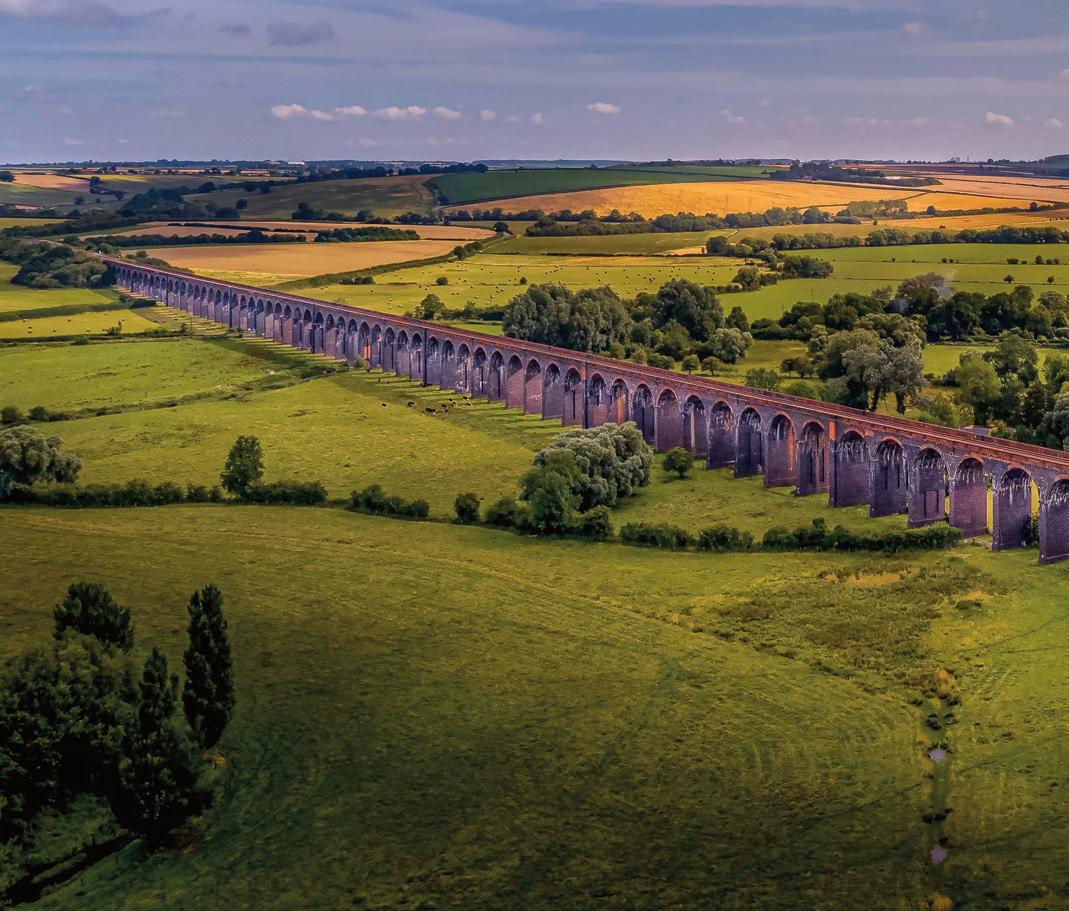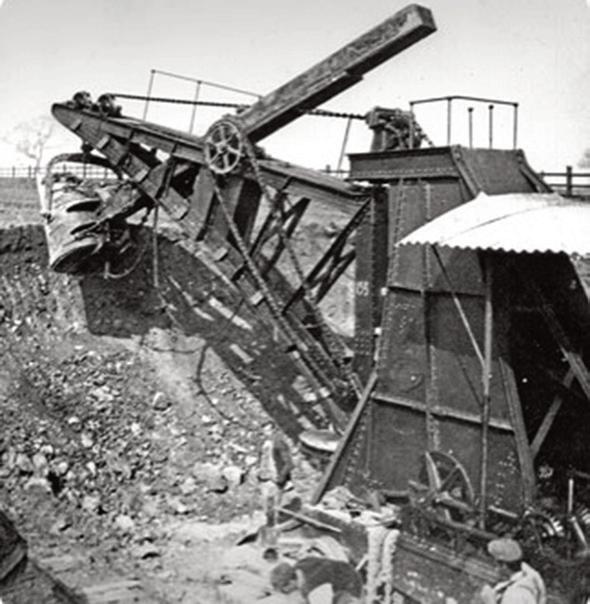
5 minute read
UNDERNEATH THE ARCHES
Words: Rob Davis. It’s difficult to imagine the landscape of Harringworth and Seaton without seeing the epic Welland Viaduct stretching across the area’s pastureland. Completed by rough old navvies from 1878, it was an epic structure, but also one that would prove essential to the economic success of the railway to the area...

Advertisement
What a ruckus HS2 has caused. Imagine, then, what locals would have thought about the prospect of their uninterrupted views being skewered by the presence of a proposed new viaduct stretching 1.166km (1,275 yards) across the county, back in 1870. The statistics of the viaduct are impressive to day the least. It has 82 arches, each of which spans 12 metres (40ft) and reaches up 21 metres (70ft) in the air. The structure comprises 30 million Blue Staffordshire bricks, as well as 20,000 cubic yards of concrete and 19,000 cubic yards of stone. The first brick was laid 145 years ago in March 1876 and the first arch was completed a year later. Construction took just two years – impressive for the time – but that timescale was achieved only because of the vast amount of manual labour invested in the epic task. From the mid to late-1700s navvies made a career for themselves as an itinerant labour force predominantly creating canals. With many of these being complete by the late 18th century, work was short. So when news came of the planned construction of a large viaduct in the area, there were plenty of men keen to undertake the strenuous and exhausting work. Around 3,000 men arrived in the area seeking work and were set on, with just gunpowder, picks, shovels and bricklaying skills to create the viaduct. Their work ethic and mannerisms were documented by Reverend D W Barrett, vicar of Nassington who published his book, Life and Work Among the Navvies The viaduct cost £12,000 to build – around £14m in today’s money – and was Grade II listed in 1987. >>



>> Needless to say the navvies were to benefit financially rather less, with labourers earning £1.10s.0d, semi-skilled bricklayers and miners earning £2.10s.0d and foremen earning £3.0s.0d. Overtime was available to those who worked through the night, and in order to accommodate the labourers, more than 40 huts were created at the Seaton end of the viaduct with 12 further huts at Gretton Hill to create a makeshift settlement. A mission hut was also created to try to temper the behaviour of the raucous group of navvies, whose consumption of ale has been estimated at about 30 gallons per hut per week. Tiddly behaviour, fighting, poaching and other naughty actions was wide-spread, as was dog fighting usually with breeds like lurchers. Appeals for temperance from the Curate of the site were somewhat less than successful. Still, the last arch was finished and a ceremony brought together contractors, foremen and workers on the Seaton side of the viaduct with Colonel Tryon, who owned the land, leading celebrations. Tryon is the great-grandfather of the land’s later owner, Mr Tim Conant, and Squire Monkton of Seaton. When the viaduct opened on 1st March 1880, it would carry eight passenger trains a day, to provide a more direct to London. It would service the 17-mile line created by The Midland Railway just a decade earlier. Five years later a new slip coach service had been created which left Oakham in the morning and connected via the line to London, and to provincial centres like Northampton, Cambridge and Kettering. By 1903 the line was carrying over a dozen express and stopping trains each way, daily. The strategic importance of the viaduct in moving troops to the channel ports during the First World War may explain a Zeppelin attack which occurred in 1916.
The viaduct was attacked by a German balloon possibly because of its strategic importance in connecting the county to the war effort. In 1939, bombing threats were also issued by the Irish Republican Army and

these resulted in the area around the viaduct being placed under guard by police. Fortunately, nothing further occurred. Unfortunately, with fewer than 15 people using Harringworth Station from 1947, the station was closed a year later, saving between £1,000 and £1,500 a year. Today, the line is on the route between Oakham and Kettering and comprises a two-track non-electrified line joining the Peterborough to Leicester line. It’s generally used for freight and for the odd steam train sortie, but a single daily passenger service was introduced in 2009 by East Midlands Trains operating between Melton and St Pancras via Corby, the first such service since the 1960s. Naturally given its age, the viaduct has suffered from the effects of the weather and from structural stress. Repairs have been made using blue engineering bricks and red bricks, which tend to be more resilient although this has resulted in a bit of a patchwork appearance in places. 2001 saw a more comprehensive restoration with the equivalent of £2.32m being spent on structural maintenance. A weight limit was also introduced in 2017 limiting trains with a weight of 25-tonnes per axle (freight trains, mostly) to just 20mph, with future work due to restore a 60mph limit. n For further information on the Welland Viaduct, see www.harringworth.org.
ROCKS BY RAIL IN RUTLAND...
Rocks by Rail – formerly know as Rutland Railway Museum, is situated four miles from Oakham and tells the local story of how private railways were used in the local ironstone extraction industry to move the extracted stone on the first part of its journey to the distant steelworks. The museum takes visitors back to the days before mass road transport when most minerals were was carried by rail and quarries had their own rail system. Now, owners of the standardgauge locomotive ‘Stamford’ which is owned by The Bluebell Railway in Uckfield (and has been on loan to the Rutland museum), have agreed to sell the museum the engine so that it can remain at the museum permanently, not far from the ironstone quarry in which it was once in daily use. The Museum is now raising funds to buy the locomotive and start the long road ahead for its repair, re-assembly and conservation as a historic museum exhibit. David Atkinson Chair of the museum said: “We are grateful to the Bluebell Railway for firstly securing the locomotive for preservation when Pilton ironstone quarry closed in 1969, secondly for allowing it to come on loan to the museum and thirdly for now offering the loco for sale to the museum so that it can remain on public display in its home county.” n For more information see www.rocks-by-rail.org.










